There are mainly two types of combinations of resistors in a circuit, series and parallel. In the given table, Column I shows voltages of different arrangements of resistors, Column II shows different arrangement of resistors and Column III shows currents of different arrangements of resistors.
What are the conditions when resistor is in the parallel network?

(I) (ii) (J)
(IV) (ii) (M)
(II) (ii) (J)
(I) (iii) (J)
The correct Answer is:D
Step by step video, text & image solution for There are mainly two types of combinations of resistors in a circuit, series and parallel. In the given table, Column I shows voltages of different arrangements of resistors, Column II shows different arrangement of resistors and Column III shows currents of different arrangements of resistors. What are the conditions when resistor is in the parallel network? by Physics experts to help you in doubts & scoring excellent marks in Class 12 exams.
Updated on:21/07/2023Topper's Solved these Questions
- CURRENT AND RESISTANCEBOOK - RESNICK AND HALLIDAYCHAPTER - CURRENT AND RESISTANCEEXERCISE - Practice Questions (Integer Type)
3 Videos
- CURRENT AND RESISTANCEBOOK - RESNICK AND HALLIDAYCHAPTER - CURRENT AND RESISTANCEEXERCISE - Practice Questions (Linked Comprehension)
5 Videos
- CIRCULAR MOTIONBOOK - RESNICK AND HALLIDAYCHAPTER - CIRCULAR MOTIONEXERCISE - CHECK POINTS
6 Videos
- ELASTICITYBOOK - RESNICK AND HALLIDAYCHAPTER - ELASTICITYEXERCISE - PRACTICE QUESTIONS (Integer Type)
3 Videos
Similar Questions
Electrical current is the flow of charged particles. The electric current flows through a wire the same way as how water moves in a river. The electricity is nothing but the flow of electrons. There are two main combinations of resistors in circuit, that is series and parallel. In the given table, Column I shows different combinations of resistors, Column II shows voltages of different arrangements of resistors and Column III shows currents and voltage division needed or not in different arrangements of resistors.
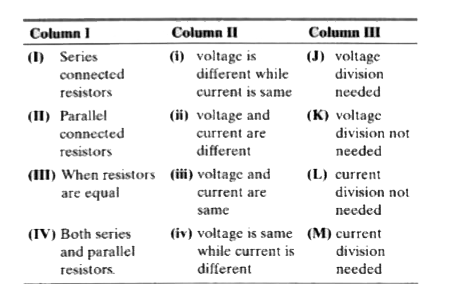
When does the voltage division problem arise?
View SolutionElectrical current is the flow of charged particles. The electric current flows through a wire the same way as how water moves in a river. The electricity is nothing but the flow of electrons. There are two main combinations of resistors in circuit, that is series and parallel. In the given table, Column I shows different combinations of resistors, Column II shows voltages of different arrangements of resistors and Column III shows currents and voltage division needed or not in different arrangements of resistors.
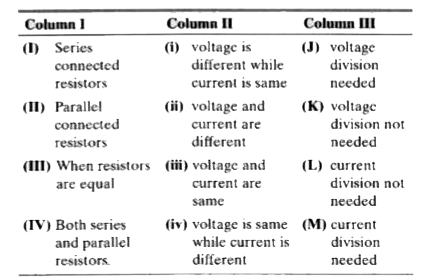
When does the current division problem arise?
View Solution
Knowledge Check
There are mainly two types of combinations of resistors in a circuit, series and parallel. In the given table, Column I shows voltages of different arrangements of resistors, Column II shows different arrangement of resistors and Column III shows currents of different arrangements of resistors.
What are the conditions when resistors are in mixed combination, that is, parallel and series combination respectively?
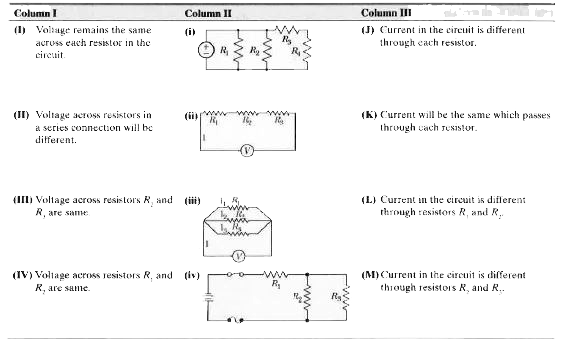 A(IV) (iv) (K)B(III) (iv) (M)C(II) (iii) (L)D(I) (i) (M)
A(IV) (iv) (K)B(III) (iv) (M)C(II) (iii) (L)D(I) (i) (M)There are mainly two types of combinations of resistors in a circuit, series and parallel. In the given table, Column I shows voltages of different arrangements of resistors, Column II shows different arrangement of resistors and Column III shows currents of different arrangements of resistors.
What are the conditions when resistors are in mixed combination, that is series and parallel combination respectively?
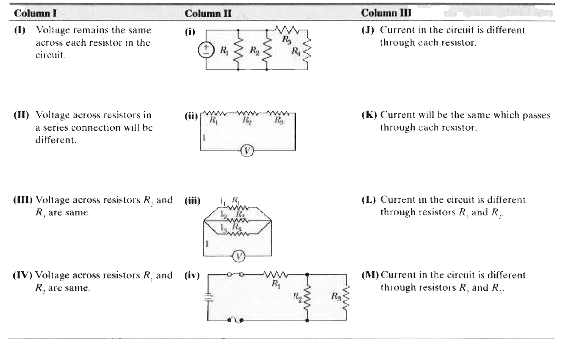 A(III) (i) (L)B(I) (i) (J)C(IV) (i) (L)D(II) (iii) (M)
A(III) (i) (L)B(I) (i) (J)C(IV) (i) (L)D(II) (iii) (M)Electrical current is the flow of charged particles. The electric current flows through a wire the same way as how water moves in a river. The electricity is nothing but the flow of electrons. There are two main combinations of resistors in circuit, that is series and parallel. In the given table, Column I shows different combinations of resistors, Column II shows voltages of different arrangements of resistors and Column III shows currents and voltage division needed or not in different arrangements of resistors.
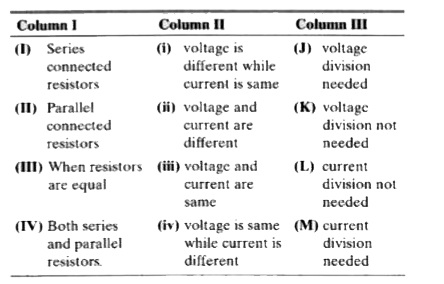
When there is no voltage division problem arise?A(II) (iv) (K)B(IV) (i) (M)C(III) (ii) (L)D(III) (iv) (K)
Interference is an important property of light. In the given table, Column I shows the properties of interfering waves, Column II shows the phase difference, and Column III shows the path difference between two interfering waves
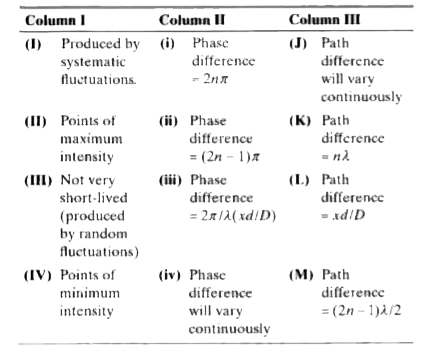
What are the conditions for destructive interference?
View SolutionIn each equation, there is a table having 3 columns and 4 rows. Based on the table, there are 3 questions. Each question has 4 options (a), (b), (c ) and (d), ONLY ONE of these four options is correct.
There are different types of lasers. In the given table, Colums I shows the properties of different lasers or material used in lasers, Column II shows the different names of the lasers and Column III shows the uses of different type of lasers.

What are the characteristics of liquid state laser?
View SolutionIn each equation, there is a table having 3 columns and 4 rows. Based on the table, there are 3 questions. Each question has 4 options (a), (b), (c ) and (d), ONLY ONE of these four options is correct.
There are different types of lasers. In the given table, Colums I shows the properties of different lasers or material used in lasers, Column II shows the different names of the lasers and Column III shows the uses of different type of lasers.
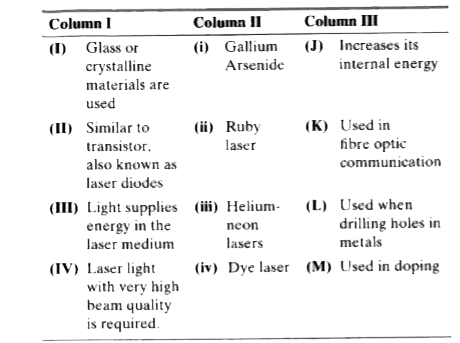
What are the characteristics of solid-state laser?
View SolutionInterference is an important property of light. In the given table, Column I shows the properties of interfering waves, Column II shows the phase difference, and Column III shows the path difference between two interfering waves
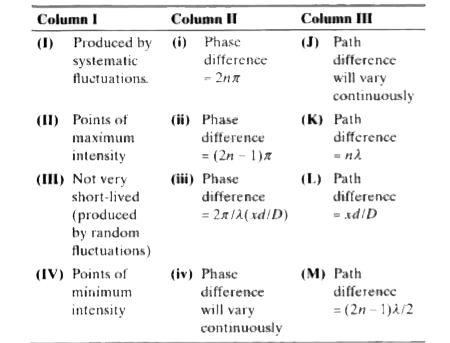
What are the conditions for sustained interference?
View SolutionInterference is an important property of light. In the given table, Column I shows the properties of interfering waves, Column II shows the phase difference, and Column III shows the path difference between two interfering waves
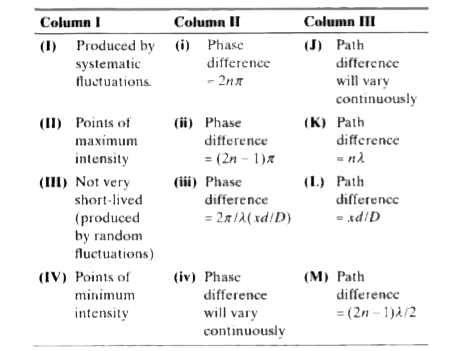
What are the conditions for constructive interference?
View Solution